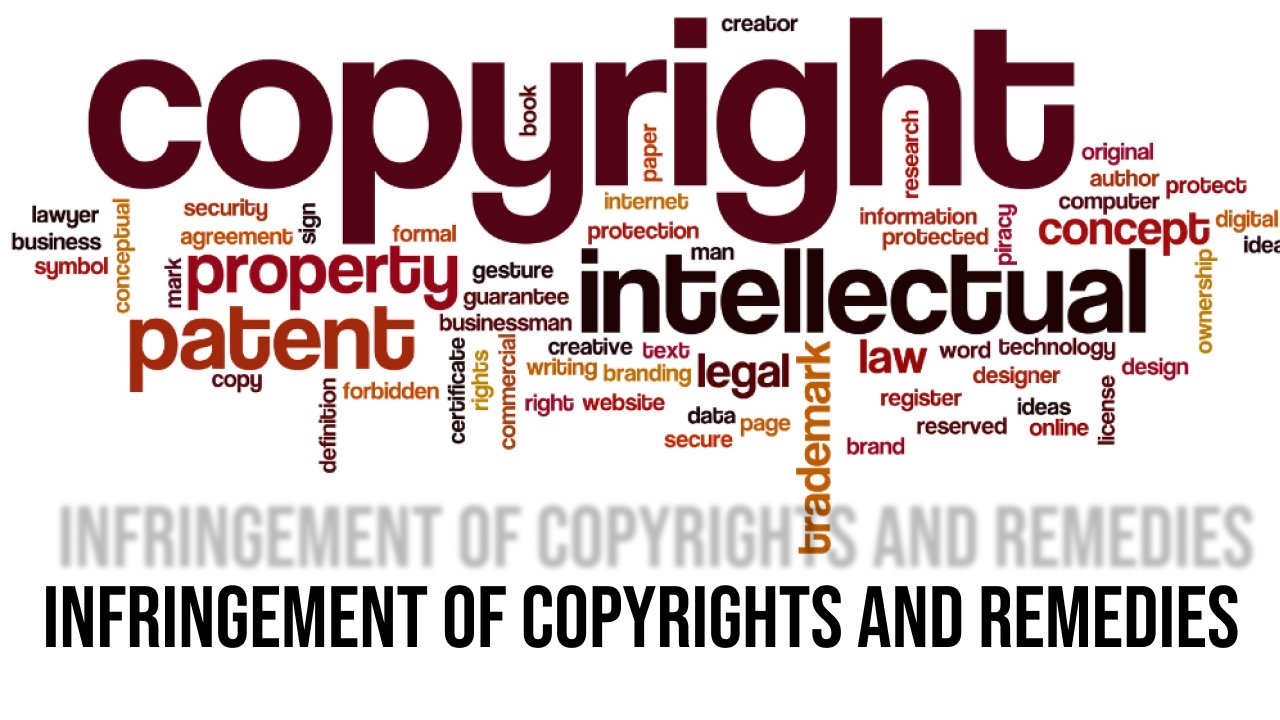Infringement Of Copyrights and Remedies
Copyright infringement is a pervasive issue in the modern digital landscape, posing significant challenges to creators and content owners. This article explores the complexities surrounding the infringement of copyrights and the available remedies to address such violations. From the unauthorised reproduction of creative works to digital piracy, copyright infringement takes various forms. We delve into legal frameworks, preventive measures, and the range of remedies available to copyright holders. Understanding the implications of copyright infringement and the avenues for redressal is crucial in maintaining the integrity of intellectual property rights.

Introduction:
In an era dominated by digital content, the infringement of copyrights has become a pressing concern for creators and content owners. The unauthorised reproduction, distribution, or use of creative works without the proper authorization undermines the very essence of intellectual property rights. This article explores the nuanced landscape of copyright infringement and examines the various remedies available to address and prevent such violations.
Understanding Copyright Infringement:
Copyright infringement occurs when someone reproduces, distributes, performs, or displays a copyrighted work without the permission of the copyright owner. With the rise of the internet, digital technologies, and social media, the avenues for infringement have multiplied, making it a pervasive challenge for creators across various industries.
Infringement can take many forms, from the blatant reproduction of entire works to more subtle violations such as unauthorised adaptations or derivative works. The digital age has also given rise to issues like online piracy, where copyrighted content is shared or distributed without the consent of the copyright owner, posing a significant threat to the economic interests of creators.
Legal Framework and Copyright Remedies:
The legal framework surrounding copyright infringement varies across jurisdictions, but it generally provides a set of remedies to address violations. Common remedies include injunctive relief, damages, and the possibility of criminal sanctions. Injunctions prevent the infringing party from continuing their unauthorised use of the copyrighted work, offering swift legal action to halt ongoing violations.
Monetary damages aim to compensate the copyright owner for the economic losses incurred due to infringement. The calculation of damages may consider factors such as the extent of the infringement, the commercial impact, and any profits gained by the infringing party. In cases of willful infringement, statutory damages may be available, providing a predefined amount without the need to prove actual financial harm.
Fair Use and Defences:
While copyright laws protect the rights of creators, they also incorporate limitations such as fair use. Fair use allows for the use of copyrighted material without permission for purposes such as criticism, commentary, news reporting, teaching, scholarship, or research. Determining fair use involves considering factors like the purpose of use, the nature of the copyrighted work, the amount used, and the effect on the market value.
Defences against copyright infringement claims may also include arguments of de minimis use (trivial use that does not merit legal action), licence agreements, or assertions that the work in question is not eligible for copyright protection. The interplay between infringement claims and these defences adds complexity to legal proceedings, emphasising the importance of legal expertise in navigating copyright disputes.
Digital Piracy Challenges:
Digital piracy represents a unique and pervasive form of copyright infringement in the digital age. Peer-to-peer file sharing, streaming services, and torrenting platforms enable the widespread distribution of copyrighted material without proper authorization. The challenge for copyright holders lies not only in identifying instances of piracy but also in pursuing legal action against often anonymous infringers.
International nature of digital piracy further complicates the legal landscape, requiring collaboration between countries to address cross-border infringements. The Digital Millennium Copyright Act (DMCA) in the United States and similar legislation in other jurisdictions attempt to strike a balance by providing mechanisms for takedown notices, but enforcement remains a continual challenge.
Preventive Measures and Technological Solutions:
To mitigate the risk of copyright infringement, creators and content owners employ preventive measures and technological solutions. Watermarking, encryption, and digital rights management (DRM) technologies are used to protect digital content from unauthorised use. Licensing agreements and contracts are employed to define the terms under which copyrighted material can be used, reducing the likelihood of disputes.
Educational initiatives also play a role in raising awareness about copyright laws and the consequences of infringement. Public campaigns and industry collaborations aim to foster a culture of respect for intellectual property rights, encouraging responsible consumption of creative works.
Conclusion:
In conclusion, copyright infringement poses a formidable challenge in the contemporary landscape of digital content. The multifaceted nature of infringement, from traditional forms to the complexities of digital piracy, requires a comprehensive understanding of legal frameworks and remedies. The balance between protecting the rights of creators and fostering innovation and fair use remains a delicate one.
As technology continues to evolve, so too must the legal and technological solutions to combat copyright infringement. Collaboration between content creators, industry stakeholders, and legal authorities is crucial in developing effective strategies to prevent infringement and swiftly address violations when they occur. Ultimately, the protection of copyrights not only upholds the rights of individual creators but also sustains the vitality of the creative industries that enrich our cultural landscape












